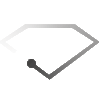
Real Diamonds v/s Fake
One of the most common questions that are asked to gemologists is how to find the difference between a real diamond and a fake stone.
While various tests can be used to tell if a diamond is real, it’s advised to have a professional diamond expert assist you in determining if a diamond is genuine. A professional gemologist who has a Graduate Gemologist (GG) degree will be able to tell you definitively if a diamond is real or not.
Bringing your stone to a diamond professional will give you peace of mind, because several proven methods and tools are used to determine if a diamond is real or not.
Follow guide is for diamonds or diamonds jewelry pieces want to know if they are real or fake.
There are certain method or test listed below.
1) Inspecting a Diamond with a Loupe
A diamond professional will have access to a loupe - a special magnifying glass used for diamonds, gemstones and jewelry. When using a loupe, a professional will look for blemishes and imperfections within the diamond. While a fake diamond can be perfectly constructed, a diamond will have small imperfections called inclusions.
2) Fog Test
For the fog test, hold the diamond or ring between two fingers and breath on it with a puff of air. A light fog will form on the diamond because of the moisture and heat in your breath.
If the fog dissipates right away, the diamond is real. If it takes several seconds for the fog to disperse, it is likely a fake diamond.
Diamonds effectively conduct heat and therefore disperse heat quickly.
3) Water Test
Use this simple test to ensure a diamond is real.Find a normal sized drinking glass and fill it ¾ of the way with water. Carefully drop the loose stone into the glass.If the gemstone sinks, it’s a real diamond. If it floats underneath or at the surface of the water, you have a fake on your hands.
A real diamond has high density, so the water test shows if your stone matches this level of density.
4) UV Light Test
To test a diamond in a different way, place it under a UV light and watch the reaction. Most diamonds will emit a blue colored glow, but not all of them. Some diamonds do not glow under UV light. For this reason, if the stone does not glow, the results don’t necessarily indicate that it’s a fake diamond.
Because this test is not definitive, it’s best to have a professional diamond expert or jeweler use their advanced equipment to test the stone.5) ‘Read-Through’ Effect
To test the diamond’s refractivity, gently place the stone flat side down onto a page of newspaper in an area with lots of lettering. Ensure the lighting is bright and that no objects or people are casting a shadow on the diamond.
If you’re able to read the letters of the newspaper—even if the letters are a bit blurry—the diamond is fake. If the diamond is real, its facets will refract the light in different directions, rather than in a straight line. Because of this refraction of light, you won’t be able to see clearly through the diamond and make out the letters on the paper.
The newspaper test is most effectively used on loose diamonds. If the diamond is in its setting already, consider using the fog test or having it reviewed by a professional diamond expert.
6) The Dot Test
The dot test is an excellent alternative of ‘Read-Through’ Effect.
Place a white piece of paper on a flat surface and draw a small dot with a pen. Lay the stone onto the dot with the flat side down. Through the pointed end of the diamond, look down onto the paper. If you see a circular reflection inside the gemstone, the stone is fake. If you cannot see the dot or a reflection in the stone, then the diamond is real.
Because a true diamond has powerful refractive qualities, light will bounce in different directions instead of a straight line. This is why you won’t be able to see letters or dots through a natural, real diamond.
7) Examining Using a Microscope
With a 1200x magnification on a power microscope, a jeweler or gemologist is able to scrutinize the stone in detail. At this level of magnification, they’ll be able to see inclusions and small differences in real diamonds compared to moissanite.
8) X-ray Examination
To have the internal, molecular qualities of a stone reviewed, send it to a professional diamond lab for testing. Their x-ray machines will be able to tell if the stone has a radiolucent molecular structure or a radiopaque molecular structure. Diamonds are radiolucent while fakes like cubic zirconium and crystals have more radiopaque features.



